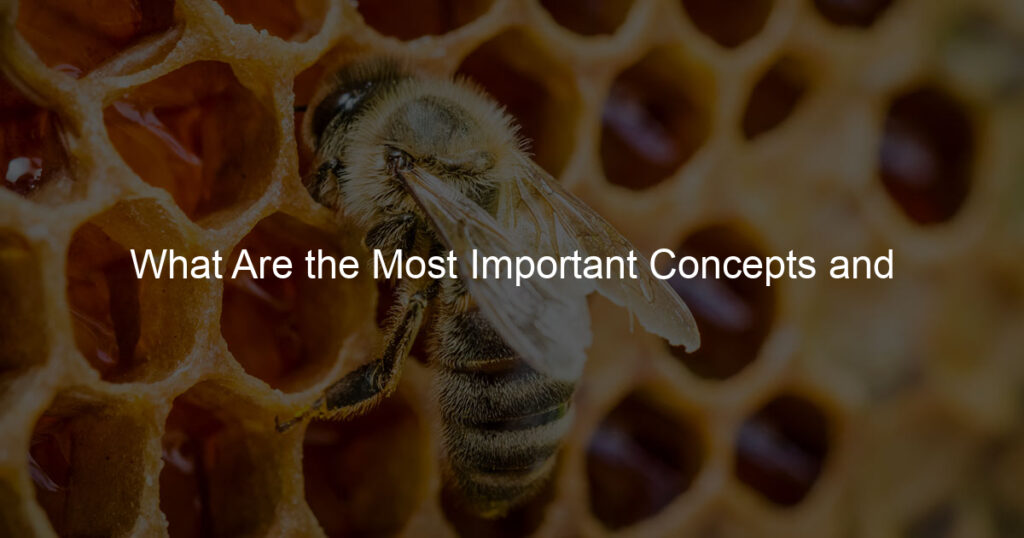Beekeeping is an amazing and rewarding hobby that can give you a unique insight into the natural world. Trying to understand the basics of beekeeping, however, can seem like an overwhelming task – there are so many concepts and principles to take on board!
In this blog post, we’re going to be walking through what we believe to be some of the most important concepts and principles that you need to get your head around if you want your journey into beekeeping to be as successful as possible. We will discuss various topics such as equipment, hive types, colony management techniques, honey harvesting, and more – all valuable for allowing you to create a safe home for your bees and acquire high-quality honey at the same time! So grab yourself a cup of tea (or coffee!) And let’s dive in.
What are the basic principles of beekeeping?
Beekeeping is an ancient and rewarding craft that can provide rewards both in the form of delicious honey, but also in gaining knowledge into the lives of our most prolific pollinators.
To be successful, one must understand the basic principles that guide a beekeeper’s decisions and actions. These fundamental tenets include recognizing different elements of the hive such as worker bees and drones, as well as being aware of essential pieces of equipment such as protective veils or smokers to protect against stings. Understanding behavior patterns, seasonal changes, and hive organization are also key aspects of successful beekeeping.
Furthermore, the best methods for incorporating queen bees into a healthy colony should be taken into consideration before beginning a journey in beekeeping.
What is the concept of apiculture?
Apiculture, also known as beekeeping, is a practice that dates back centuries. It focuses on the management of honey bee colonies to produce honey and other bee products such as beeswax, propolis, and royal jelly. Unfortunately, in recent years basic apicultural practices have become less popular due to increased urbanization and pesticide use among other reasons.
It is important to recognize however that bees are vital in maintaining a healthy ecosystem due to their role as food pollinators. As such it can be beneficial for any gardener or farmer to adopt this hobby to increase crop production. With dedication and a bit of research, anyone can master the basics of apiculture and help to protect our environment at the same time!
What is the primary objective of beekeeping?
Beekeeping is the practice of caring for colonies of honeybees, and it’s been around longer than you might think. Its purpose is multi-faceted and includes both agricultural interests as well as environmental conservation.
First and foremost, beekeeping serves to provide a source of honey throughout the year. The sweet substance is produced naturally by bees from harvested flower nectar, and beekeepers depend on it to produce products like a raw honeycomb, and even bee pollen or beeswax for additional items like candles or lip balm. Additionally, many honeybee farmers must tend to the hives to pollinate other nearby wild crops such as fruits, vegetables, and nuts.
This helps ensure their continued growth and success in surrounding ecosystems and ultimately contributes to broader biodiversity throughout the area where bees are kept.
What is the 7/10 rule in beekeeping?
The 7/10 rule in beekeeping is a strategy to determine the effectiveness of a hive’s honey production. In essence, it requires that a beekeeper extract the honeycomb frames from one-third or 7 out of 10 brood frames–frames used to house bees in development.
If enough honey is recovered, this method can help gauge whether or not the colony will yield a good harvest. Popularized by Michael Bush, author of “The Practical Beekeeper,” this practice allows beekeepers to measure how much food bees are storing for winter without waiting until the end of the season when there may not be enough time for them to breed more workers to replace those that have died off over the winter months.
By using the 7/10 rule, beekeepers can make sure their hives remain healthy and productive.
What is the rule of the queen bee?
The ‘rule of queen bee’ states that a female worker bee must be in charge of the hive or nest to ensure its fertility and growth. The queen bee is typically much larger than the other bees and serves as the primary egg layer for the entire colony.
She is responsible for leading her drones and workers in searching for food, building wax comb, protecting larvae, laying eggs, and dispersing pheromones to warn the hive if danger approaches. Due to her importance to the health of the hive, she is usually surrounded by several nurse bees whose sole purpose is to care for her every need.
A queen bee plays an invaluable role in ensuring the wellbeing of her colony; without her leadership and fertility, it cannot survive—making her quite literally ‘the Bee’s Knees’.
Winding Down: What Are the Most Important Concepts and Principles To Understand in Beekeeping?
Beekeeping is an incredibly rewarding activity that requires patience and dedication. While the concepts and principles necessary to understand may seem daunting when first beginning, having a strong foundation of knowledge will provide the best results in terms of bee health and honey production.
From understanding the biology and behavior of honey bees to being aware of how various pests and diseases can affect hives, these important concepts must be fully grasped before diving into beekeeping as a hobby or profession. With proper preparation and an inquisitive mindset, anyone can learn the fundamentals of beekeeping quickly—and start on the path to becoming a successful beekeeper.








